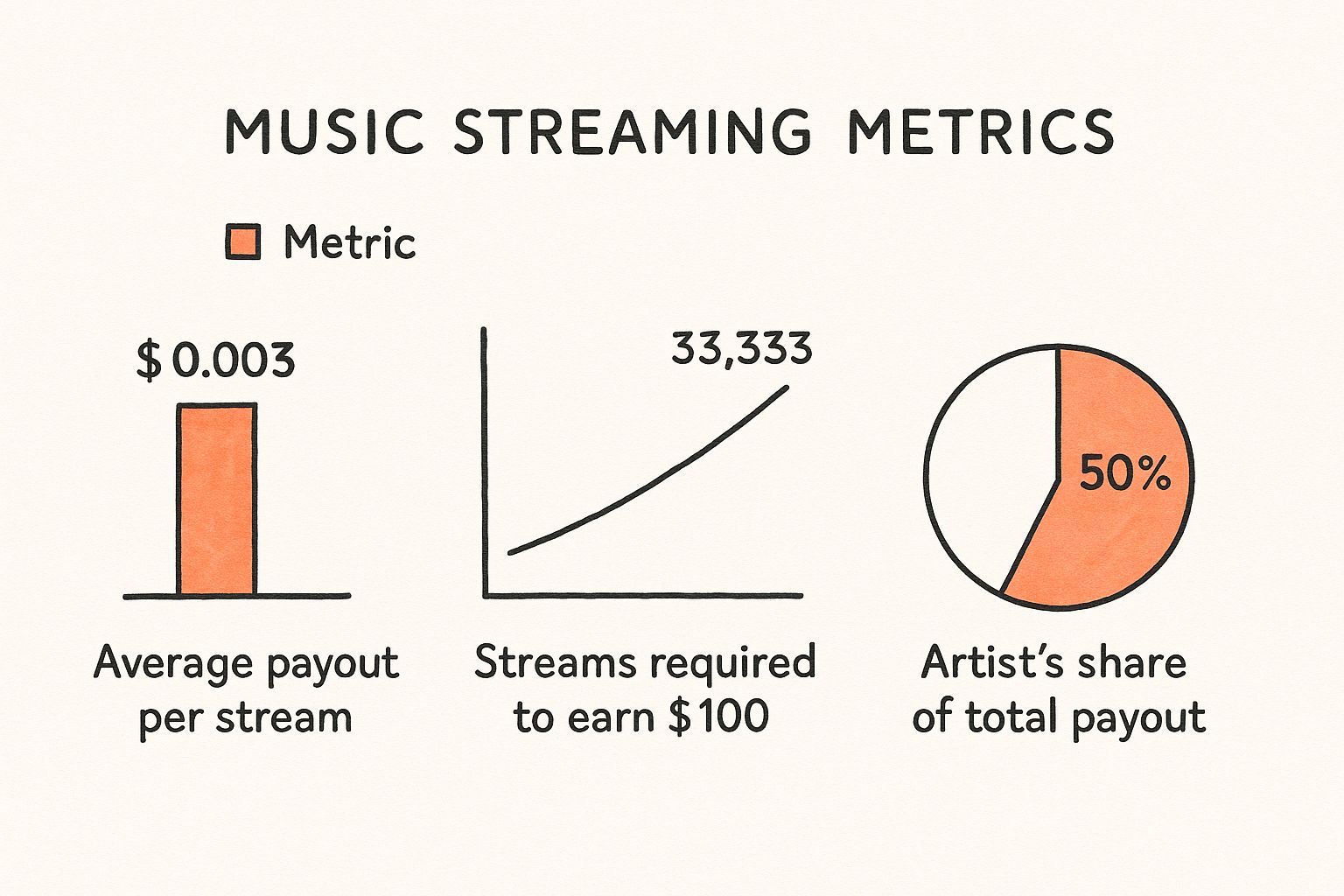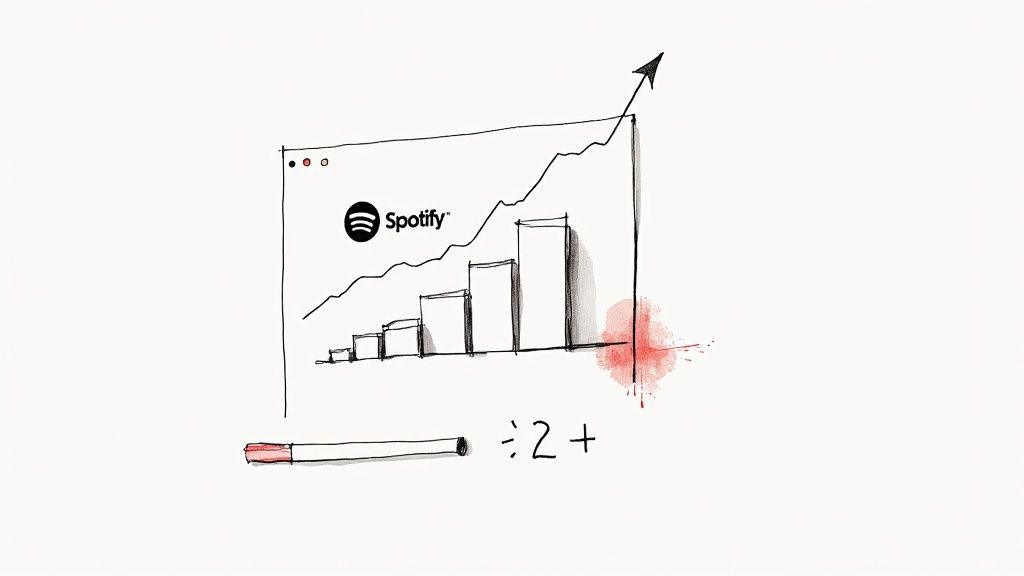Spotify Artist Earnings Calculator: Unlock Your True Revenue
- samuelfarrell
- Jun 18
- 11 min read
Understanding How Spotify Earnings Calculators Actually Work
Let's be honest, trying to figure out Spotify royalties can feel like a guessing game. A Spotify artist earnings calculator isn't a magic wand, but it's one of the best tools we have to get a realistic picture of your potential income from the platform's notoriously complex payment system. For any artist serious about building a career, knowing how these calculators work is key to making smart financial moves.
At its heart, a calculator takes your total streams and multiplies them by an estimated per-stream payout. The catch? That payout rate is all over the place. Industry estimates often float between $0.003 and $0.005 per stream, but your actual rate depends heavily on who is listening and where they are. This means 1 million streams might translate to $3,000 or it could be $5,000, and the real number often lands somewhere in the middle.
More Than Just a Simple Multiplier
The best calculators don't just pick a single, rosy number. They try to account for the variables. A stream from a Premium subscriber in the United States is worth significantly more than a stream from a free, ad-supported user in a country with lower ad revenue.
To give you a clearer idea, here’s a breakdown of how much these rates can differ. This table shows typical payout ranges based on the listener's subscription type and general region.
Region | Premium Streams | Free Tier Streams | Average Rate |
|---|---|---|---|
US/Canada | ~$0.0045 | ~$0.0010 | ~$0.0035 |
Europe | ~$0.0040 | ~$0.0008 | ~$0.0030 |
Latin America | ~$0.0020 | ~$0.0005 | ~$0.0015 |
Asia | ~$0.0015 | ~$0.0004 | ~$0.0010 |
As you can see, the makeup of your audience directly impacts your bottom line. A fanbase concentrated in high-payout regions with Premium accounts will earn you much more per stream. You can discover more about these payout variances and the factors that influence them.
This infographic breaks down some of the key benchmarks, visualizing both the challenge and the opportunity for artists on the platform.

The data makes one thing clear: hitting even modest earnings goals takes a huge number of streams, and as the artist, you only receive a portion of the total revenue generated.
From Estimation to Financial Planning
This is exactly why a good Spotify artist earnings calculator is such a vital piece of your toolkit. It helps shift your mindset from wishful thinking to actual strategic planning. A reliable tool like the Artist Tools Spotify Royalties Calculator is built using real industry data, giving you a solid foundation for setting revenue goals and tracking your progress.
When you have a realistic projection, you can build a more sustainable career. Grounding your expectations in data allows you to make smarter decisions about your next release, tour, or marketing push. For more context, check out our guide on what Spotify artists actually make.
Gathering The Right Data For Meaningful Results
Any calculator is only as good as the numbers you feed it. Before you even touch a professional Spotify artist earnings calculator, like the one from Artist Tools, your first stop should be your own Spotify for Artists dashboard. This is where you swap vague guesses for hard data, turning a simple estimate into a powerful financial planning tool. Relying on public stream counts alone is a recipe for a bad forecast.
Digging into Your Spotify for Artists Dashboard
Think of your dashboard as the command center for your music. It's not just for watching your follower count tick up; it's a goldmine of the specific details that directly impact how much money lands in your bank account. Here’s what a typical audience overview looks like.

This simple snapshot tells you so much more than a total stream number. Seeing that a big chunk of your listeners are in the US or UK, versus a region with a lower payout rate, is crucial information that a basic stream counter completely ignores.
Key Metrics That Fuel Your Calculation
To get a truly accurate projection, you need to pull a few specific numbers from your dashboard. Forget the vanity metrics and focus on what actually moves the needle on your revenue. Here’s what to look for:
Total Streams in a Set Period: Don't just plug in your all-time stream count. For a more realistic baseline, grab your streams from the last 28 days or 90 days. This gives you a snapshot of your current momentum, not your past performance.
Top Countries: Like we just saw, where your streams come from is a huge deal. If 60% of your streams are from the United States, your average per-stream rate will be significantly higher than if that same percentage came from a lower-payout territory.
Listener Demographics: While Spotify doesn't hand you a "Premium vs. Free" listener breakdown, you can make some smart inferences. If your audience is highly engaged and driven by active playlisting, that often points to a higher concentration of Premium listeners, which can boost your average per-stream rate.
Gathering this information yourself transforms a Spotify artist earnings calculator from a fun toy into a genuine business analytics tool. It’s the difference between wishful thinking and building a financial strategy you can actually count on.
Running Your Calculations Like A Music Business Pro
Alright, you’ve got your Spotify for Artists data ready to go. But what do those stream counts actually mean for your bank account? To bridge that gap, we'll use a Spotify artist earnings calculator, like the one from Artist Tools, to turn raw stats into a realistic financial picture.
When you open the calculator, your first instinct might be to enter your all-time stream count. While seeing a huge number is satisfying, it won't give you an accurate forecast. Instead, focus on your recent performance. Use your stream count from the last 28 days or 90 days to get a true sense of your current earning power. For instance, if you have 1 million lifetime streams but pulled in 50,000 last month, that 50,000 is the number you should use. It reflects your current momentum, not your entire history.
Modeling Different Outcomes
Now for the fun part—this is where the calculator becomes a strategic tool, not just a number-cruncher. Don't just plug in your numbers once and call it a day. A single calculation only tells you what's happening right now. By running a few different scenarios, you can map out potential futures and make smarter financial decisions for your music career.
To get a complete view of your potential earnings, try modeling these three key situations:
The Baseline: This is your "business-as-usual" scenario. Use your current 28-day stream count to see what you can expect if everything stays the same.
The Growth Goal: What if your next single lands on a big playlist? Project a 25% increase in your monthly streams to see what a successful promotional push could look like in dollars and cents.
The Conservative Estimate: Let's be real, not every month is a hit. Model a 20% drop in streams to understand your floor. This number is crucial for smart budgeting and managing your cash flow during slower periods.
Laying these three numbers out next to each other is incredibly powerful. The calculator stops being a simple estimator and becomes a genuine planning tool. Suddenly, you can see exactly what a good playlist placement is worth in real money, giving you concrete financial targets that can fuel your entire marketing strategy.
Interpreting Your Results With Real-World Context
Okay, so you've punched in your stream counts and the calculator has spit out a number. It's always a thrill to see that potential earnings figure, but let's be real—that number is just a starting point. The real magic happens when you translate that raw estimate into something you can actually use to plan your music career. It's all about figuring out where your projection fits into the bigger picture so you can set goals that are both ambitious and achievable.

Sizing Up Your Earnings Against the Industry
Your first move should be to see how your results compare to what other artists are making. A Spotify artist earnings calculator is helpful because it grounds your expectations in the tough realities of streaming income.
The truth is, the distribution of earnings is incredibly wide. For example, in 2023, while over 103,400 artists earned at least $5,000 in royalties from Spotify, only 20,500 artists managed to cross the $50,000 threshold. This context is critical. It helps you understand if your current trajectory is pointing toward a nice side hustle or a full-time career.
To give you a clearer idea, here's a breakdown of how many artists are hitting various income levels on Spotify each year.
Artist Earnings Distribution on Spotify
Breakdown of how many artists reach different income milestones annually
Annual Earnings Range | Number of Artists | Percentage of Total | Streams Required (Approx.) |
|---|---|---|---|
$1,000 - $4,999 | ~517,600 | ~4.7% | 250k - 1.25M |
$5,000 - $9,999 | ~37,400 | ~0.34% | 1.25M - 2.5M |
$10,000 - $49,999 | ~45,500 | ~0.41% | 2.5M - 12.5M |
$50,000+ | ~20,500 | ~0.18% | 12.5M+ |
Note: Data based on 2023 industry reports. The "Percentage of Total" is based on an estimate of 11 million total artists on the platform. [You can explore more about these artist earning tiers to get a deeper dive](https://www.venicemusic.co/blog/how-much-do-artists-make-on-spotify-a-realistic-breakdown-for-2025).
This table shows that while hundreds of thousands of artists are making meaningful money, the group earning a sustainable living wage from Spotify alone is much smaller. The key takeaway is to use these tiers as milestones for your own growth.
Why Your Estimate Might Be Skewed
Before you start budgeting based on that calculator number, take a breath. The figure you see is a snapshot in time, not a guaranteed annual salary. Several things can throw off your estimate, giving you a warped view of your real, consistent earnings. Always ask yourself if these factors are in play:
The Viral Hit Hangover: Did one of your songs just blow up on TikTok or Reels? That's incredible, but that surge in streams is often temporary. Enjoy the ride, but don't expect that spike to become your new baseline overnight.
The Big Playlist Bump: Getting added to a major editorial playlist like New Music Friday can feel like winning the lottery. It delivers a massive boost, but those placements are rarely permanent. When your track gets rotated out, your stream count will likely dip.
Location, Location, Location: Not all streams are created equal. A million streams from listeners in high-payout countries like the U.S. or Norway will earn significantly more than a million streams from a region with lower subscription costs.
The Payout Pie: The number on the calculator is gross revenue. It’s the total amount earned before anyone else takes their piece of the pie. From this number, you still need to pay cuts to your distributor, label (if you have one), publisher, and any co-writers or producers.
Refining Your Estimates For Strategic Planning
Getting a number from a Spotify artist earnings calculator is exciting, but it's just the first step. To make real moves in your career, you need to dig deeper than that initial figure. This is where you shift from a simple estimate to a full-blown financial strategy that can guide your decisions.
Accounting For Real-World Volatility
Let's be real—your stream count is never a flat line. That holiday song you released might pop off in December, but those numbers won't hold up in March. Likewise, getting a spot on a popular playlist can give you a massive, but temporary, boost.
Instead of basing your entire year's forecast on a single great month, look at a three-month rolling average. This smooths out the peaks and valleys, giving you a more realistic picture. Treat those big wins as awesome outliers, not your new normal. This careful planning is so important because in 2024, Spotify paid out an incredible $10 billion to the music industry. But remember, that giant pie is being split between millions of artists, which is why individual earnings vary so much. You can learn more about how these industry payouts are structured.
Creating Actionable Financial Scenarios
Now for the fun part: creating different financial scenarios based on your actual plans. Don't just hope for "growth"—get specific. For instance, what happens if your next single lands on two decent playlists? You could model a 15% bump in streams for 60 days and see what that does to your bottom line.
Or, what if you put $300 into a marketing campaign? Project a modest 5% increase in streams to check if that investment actually pays for itself. This turns your calculator from a passive tool into an active part of your marketing strategy. When you model your goals like this, you start getting answers to some of your biggest questions.
These detailed projections help you:
Allocate your budget: Figure out exactly how much cash you can realistically put back into new gear, music videos, or a promo push.
Define your milestones: Set monthly income goals that are based on real data, not just wishful thinking.
Make smart investments: Decide if that PR agency or artist collaboration is a good financial move by estimating its impact on your streams.
By mapping out these potential outcomes, the calculator becomes more than just a number-cruncher; it’s a tool for building your career. It gives you the financial clarity you need to stop guessing and start making confident, strategic moves. If you want to go even deeper, check out our complete guide on building real music income.
Avoiding The Mistakes That Sabotage Your Projections

The Gross vs. Net Reality Check
The biggest trap is confusing gross revenue with your actual take-home pay. The number the calculator spits out is the total amount your music earned before anyone else gets paid. Your distributor, publisher, co-writers, and label all get their slice of the pie first, based on your contracts.
For instance, a $1,000 projection looks amazing on screen. But after your distributor takes a 15% fee and you split the rest 50% with your producer, that initial $1,000 shrinks to less than $425 in your pocket. Knowing this difference is essential for any real financial planning.
Overlooking Your Audience's Real Value
Another common oversight is assuming a single, universal per-stream rate for all your plays. The truth is, the payout rate changes depending on where your listeners are. If your fanbase is mostly in a country with lower subscription fees, your per-stream earnings will be much lower than the rates you often hear about for the US or Europe.
This is why you have to check your numbers against your Spotify for Artists dashboard. Digging into where your listeners are from is the key to making realistic forecasts. When you understand your audience's geography, your projections become much more accurate. You can learn how to leverage these stream data insights to build a financial model that truly works for your career.
Turning Calculator Insights Into Streaming Success
So, you've played around with a Spotify artist earnings calculator from Artist Tools and have some numbers in front of you. That's a great first step, but the real magic happens when you use those insights to build a real strategy for your music. It’s time to take those projections and make them drive decisions that actually grow your income. This isn't just about doing math; it's about turning your art into a sustainable business.
Setting Actionable Financial Milestones
Your calculator estimates are the perfect tool for setting real, concrete goals. Forget vague ambitions like "I want more streams." Now you can set specific financial targets that mean something. For instance, what if the calculator shows that a 20% increase in your monthly streams could bring in an extra $500? That's not a guess anymore; it's a target.
With that number in mind, you can decide to invest a portion of your current earnings into a focused ad campaign. You have a clear goal: hit that 20% mark. This turns a simple projection into a smart, actionable business plan.
Making Smarter Strategic Decisions
This is where you stop guessing and start making informed moves. By comparing your actual earnings to what the calculator projected, you can quickly see which songs, playlists, or even countries are your biggest earners.
Find Your Hotspots: Are most of your valuable streams coming from listeners in Germany? Great. Aim your next social media ads or collaborations toward that market to get a better return on your spending.
Time Your Drops: Do you see a consistent dip in your streams every August? Maybe hold off on that big single and plan your release for early September to catch the upswing.
Decide Where Your Money Goes: Wondering if hiring a publicist or paying for a feature with another artist is worth it? Your projections can help you calculate the potential return and decide if it's a sound financial move.
Ultimately, knowing your numbers gives you the confidence to build a career based on solid planning, not just hope. Ready to turn your streaming data into a clear financial roadmap?
[Get started with the Artist.Tools Spotify Royalties Calculator today!](https://www.artist.tools/spotify-royalties-calculator)
Comments